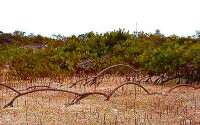Mangroves what they are and why they matter*
- Date
- 21 Jan 2014
- Start time
- 7:30 PM
- Venue
- Tempest Anderson Hall
- Speaker
- Dr. Peter Hogarth

*This lecture replaces the previously advertised lecture by Gillian Hovell.
What are mangroves? To most people the word conjures up – if anything – an image of a fetid swamp, rife with dangerous beasts This is true (up to a point!), but is only a part of the truth. Mangrove trees thrive where no other plants survive, and have evolved ways to cope with living in sea water and being permanently waterlogged. Because of this, they create a unique environment which would not otherwise exist: a tidal forest. Mangrove forests house and sustain a diverse and fascinating ecosystem.
Why do they matter? (Apart from enthusing biologists, that is.) Any ecosystem with a total area, worldwide, 12 times greater than that of Yorkshire is important! More particularly, mangroves are the basis of local fisheries, shrimp farming, domestic fuel supply, construction materials, and tourism; they protect the coastline against typhoons and tsunamis; and it is becoming increasingly apparent that they will play a key role in our struggle to adapt to the effects of climate change.
Report
Mangroves form intertidal forests in tropical regions, and live both on land and in the sea. Salt and waterlogging normally kill plants: salt by interfering with cell functions and waterlogging by drowning the roots; but mangroves have developed varied solutions for dealing with the conditions. They have a root membrane that provides a physical barrier to salt, keeping it separate from the sensitive part of the cell. They can also store salt in their bark or in their leaves, which as an evergreen plant they are continually shedding. Waterlogging is overcome by having aerial roots and air-conducting tissue, a labyrinth of passages, pneumatophores (air carriers), filled with air making them extremely light.
The many species of mangroves provide the basis of rich ecosystems, which support a wide range of living things, including humans for whom they also provide both a sustainable fuel and building material: charcoal burning is found alongside mangrove-dependent fisheries. Mangrove roots, by dissipating the power of the sea are invaluable for stabilising coastlines, and in the 2004 tsunami actually saved lives. Despite being so valuable, 1-2% of mangroves are destroyed each year through land concessions and large-scale development. There is an urgent need for effective international action to reverse this trend and protect these rich mangrove ecosystems.
Catherine Brophy